When the Seattle skies clear on a crisp winter day, there’s hardly a more majestic sight (and a welcome one after days of gray) than Mount Rainier rising triumphantly in the distance. From afar, it’s difficult to wrap our brains around just how massive this behemoth volcano is. Rising to a staggering altitude of 14,410 feet (which is even more awesome noting that Seattle sits at sea level), the giant statovolcano is the tallest peak in the Cascade Volcanic Arc, the most glaciated mountain in the Lower 48, and it is the visual epicenter of Mount Rainier National Park.
If you’re not yet subliminally persuaded to plan a snowshoeing trip to Mount Rainier National Park this winter, here’s the hard sell: Paradise Valley—situated far below the summit at 5,400 feet in elevation—has been buried under nearly 643 inches of snowfall each year (on average) since 1920. And, in 1972, that number jumped to 1,122 inches, easily asserting itself as a world record at that time.
As an added bonus, you’ll invariably run into smaller crowds than the throngs that flock in the summertime. With a permit, you're highly likely to find yourself some perfect and solitary snow camping in the backcountry. If you’re not quite into that level of adventure, warm lodges abound in the area, and you can find yourself a cozy bed and a just-as-stunning morning view.
Doubtless, there are nearly endless opportunities for snowshoeing out in the park during the wintertime—we’ve highlighted our favorite five below. ALWAYS be sure to check with the rangers before setting out. Even if a trail looks well trafficked and you’re unable to spot adverse conditions, consult a ranger. Conditions can change shockingly quickly around a behemoth volcano that creates its own weather.
Likewise, if you’re considering a more involved snow travel trip, consider completing your Avalanche 1 course (at least read the warning below) before you do so. There’s so much to learn—and so much consequence for the blissfully, and dangerously unaware.
Backcountry Safety
Winter backcountry adventures can be dangerous outdoor activities that pose significant risks as conditions affecting safety (i.e. weather, snowpack stability, avalanche hazard) are constantly changing. Prior to engaging in these activities each individual should get the proper training to make safe decisions and be equipped to use avalanche safety resources and tools. Please visit our Backcountry Skiing and Avalanche Safety post to learn more.
1. Edith Creek Basin
1 mile round trip | 240-foot elevation gain | Easy
This is an excellent introduction for those looking to figuratively get their feet wet. This is perhaps the most classic winter adventure in the park, notable for its friendly terrain and downright stunning views from the trail’s end at Panorama Point.
2. Nisqually Vista
1 mile round trip | 200-foot elevation gain | Easy
Like Edith Creek, this is an excellent choice for beginners—the moderate loop winds through a stunning forest before it reaches a stellar viewpoint situated above the Nisqually River (though you might have been able to deduce that simply from the name itself).
3. Paradise Valley
2.8 miles round trip | 550-foot elevation gain | Moderate
As evident by the seriously stunning images and the shameless plug above, Paradise Valley serves up arguably the best views on the mountain. The surrounding Tatoosh are downright eye popping and, to boot, after a short one way, you’ll find yourself atop a 176-foot waterfall.
4. Carbon River to Ipsut Falls
11 miles round trip | 1,100-foot elevation gain | Strenuous
Unlike the first three, you’ll be unable to spot the summit of Mount Rainier for nearly the entirety of the trail, and it will not find its terminus at a jaw-dropping viewpoint. That said, though, your chances at solitude, of making tracks, and of getting a glimpse of still-active animals is much, much higher.
5. Comet Falls
3.8 miles round trip | 1,200-foot elevation gain | Moderate to strenuous
Despite its impressive mileage and elevation gain numbers, this is a well-traveled trail throughout the year. The reason behind this is no secret—not only are the falls stunning and impressively tall but the bang for your buck is quite high. So, while you’ll probably not find solitude, you most likely won’t be breaking trail uphill. Plan to visit early in the workweek to beat the crowds.


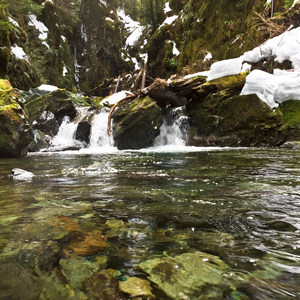
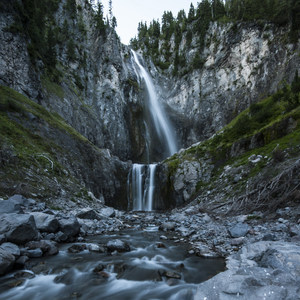
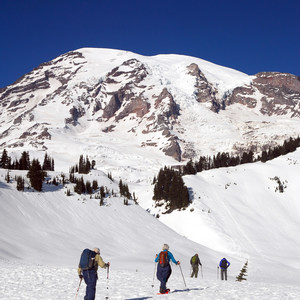
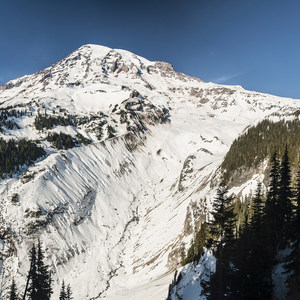
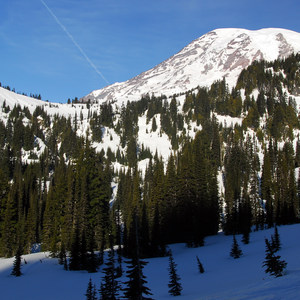



Comments
Sign In and share them.